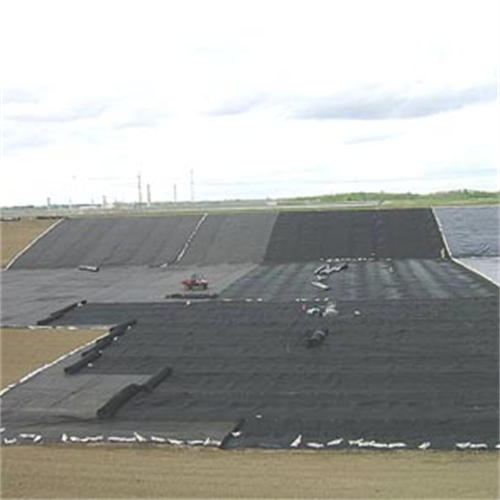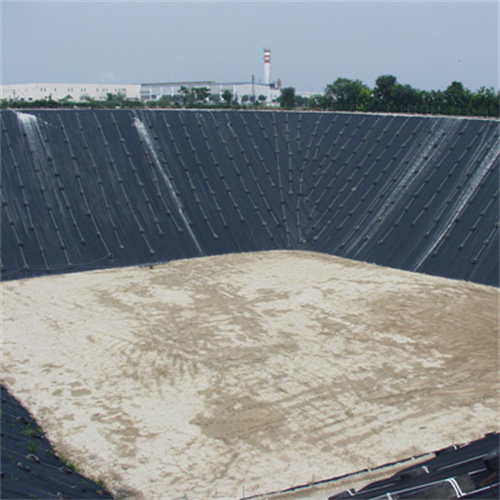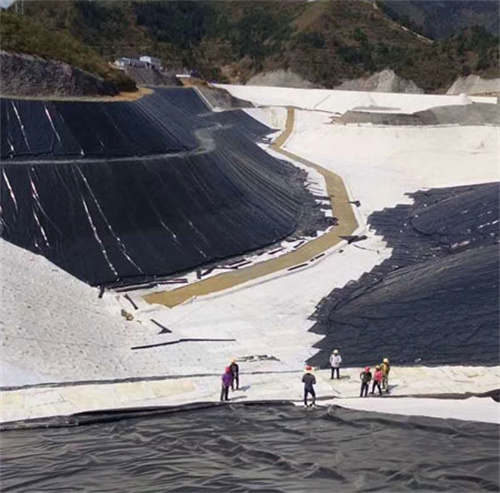Address
Mengshan Road, Wenyang Industrial Park, Laiwu District, Jinan City, Shandong Province
Phone
+86 151 6634 6139
[email protected]
[email protected]
Address
Mengshan Road, Wenyang Industrial Park, Laiwu District, Jinan City, Shandong Province
Phone
+86 151 6634 6139
[email protected]
[email protected]

Geomembrane liners are an integral part of many civil engineering projects and environmental containment systems. As their name suggests, geomembrane liners are membranes that are used for geoengineering and containment purposes. They provide a barrier that controls fluid migration and protects the surrounding environment.
A geomembrane is an impermeable membrane liner made from polymeric materials that is used for geotechnical, civil, and environmental engineering applications. Geomembranes come in long rolls of sheeting that can be deployed over large areas and welded together to create an impermeable barrier. They are used as barriers in applications that require prevention of fluid migration.
Some of the most common materials used for geomembrane liners are:
HDPE is one of the most widely used materials for geomembranes as it offers high tensile strength, chemical resistance, and endurance. HDPE geomembranes are lightweight, flexible, and easy to install. PVC and LLDPE are also popular options. The material is chosen based on the specific project requirements and application.

Geomembrane liners have a wide range of applications in civil engineering projects and environmental protection systems. Here are some of the common uses of geomembrane liners:
One of the most prevalent uses of geomembrane liners is as bottom barriers and top covers at landfills. The liner contains the waste and prevents the contamination of surrounding soil and groundwater by landfill leachate. Modern landfills are required to have a geomembrane liner system as per environmental regulations.
Geomembrane liners are installed at mining sites as part of a containment system around mine tailings ponds and heap leach pads. This prevents the release of pollutants from mining operations into the environment.
Lining canals and reservoirs with geomembranes helps prevent seepage losses and preserves water supplies. Geomembranes can cope with the hydrostatic pressure in these applications.
Spray applied geomembranes or geo-sheets can serve as waterproofing layers in underground structures like tunnels, basements, and underground parking garages.
Geomembranes provide secondary containment around fuel and chemical storage tanks to contain any leaks or spills.
Geomembranes are used to line irrigation canals and animal waste lagoons in agricultural settings. This helps conserve water and manage agricultural waste.
Lining stormwater retention ponds with geomembranes contains collected rainwater and runoff and prevents infiltration into ground.
Geomembrane liners need to demonstrate certain performance capabilities to function successfully in their intended applications. Here are some of the essential properties and requirements:
Proper formulation and manufacturing creates geomembranes with these essential performance attributes.
Polymeric geomembranes are engineered through various processes like extrusion, calendaring, and spread coating. Here is a look at the common manufacturing methods:
The most widely used process for producing geomembranes is extrusion. Polymer material is melted at high temperature and extruded through a die into a sheet profile. HDPE geomembranes are typically made by the extrusion process. Extrusion lines can produce sheets of over 15 meters in width.
This process uses heated rollers and pressure to create thin, uniform polymer sheets. PVC geomembranes are often manufactured by calendaring. It is a continuous process where the polymer paste is squeezed between heavy rollers into a sheet.
Liquid resin systems are spread coated onto a textile backing to produce geomembranes. Material is spread on the fabric scrim reinforcement as it passes under the coating head. CSPE and polyester reinforced PVC sheets are made by spread coating.
Manufacturers use quality control and testing to ensure their geomembranes meet the specified properties. They also create large rolls for efficient transportation and deployment at site.
Proper installation of geomembrane liners is crucial to create an impermeable barrier that provides long term containment performance. Here are the main installation techniques:
The seams where adjacent liner sheets are joined are the most critical part of installation. Seaming is done by thermal fusion processes that soften the adjacent surfaces and fuse them together. Automated thermal welders are used to make continuous seam welds. Extrusion welding and wedge welding are commonly used processes.
Anchor trenches are dug around the perimeter of the lining area. The edges of the geomembrane liner are secured in these trenches, usually with compacted clay or concrete. This prevents uplift or shifting of the liner.
Pipes, structural supports, and other elements that penetrate through the geomembrane need to have proper sealed connections called boots. This prevents these penetrations from becoming pathways for leakage.
NDT techniques like air pressure testing are used to ensure leak tight seams and connections. Any defects can be identified and repaired.
Proper soil cover and protection layers are placed over the installed geomembrane to prevent damage. Geotextiles are often used above and below the liner for protection.
With quality installation, the geomembrane liner forms an impermeable barrier tailored to the site conditions.

Like any material, geomembrane liners can sometimes develop defects either during manufacture or over their service life. Rigorous testing helps identify any flaws that may impact barrier performance.
Here are some key types of testing:
Manufacturers use quality control testing on their production lines to detect defects and ensure specifications are met. This includes inspections, sampling, and non-destructive testing.
The integrity of seams where sheets are joined is verified through methods like air pressure testing, vacuum boxing, and ultrasonic testing. Any failed seams are repaired.
A conductive geomembrane is energized, and areas of leakage can be pinpointed when current flows through defects.
Sample coupons are cut from the geomembrane liner and tested for properties like thickness, impact resistance, tear strength, and chemical resistance.
Once installed, non-destructive testing of the whole liner can identify any damage from construction activities.
With rigorous testing, any geomembrane defects can be identified and addressed through repairs or patching.
Sometimes defects or damage occurs in a geomembrane liner during installation or over its service lifetime. A range of repair techniques are available to restore barrier integrity.
Patches of geomembrane material welded over the damaged section provides a simple repair. The patch should extend past the defect area.
Small tears or holes can be repaired by spot welding the liner back together. This works for limited small defects.
Larger areas of damage can be remedied by topping – where a geomembrane cap sheet is bonded over the damaged liner with adhesive or thermal welding.
Portions of liner can be completely removed and replaced if repairs are not feasible. This allows for full integrity restoration.
Special repair compounds can be pressure injected beneath the liner to fill voids and seal leaks.
With an organized repair protocol, damage to installed geomembrane liners can be addressed effectively.
Geomembrane liners provide superior seepage control compared to compacted clay liners. However, both materials are sometimes used together for optimal containment.
Often both materials are used together to utilize the strengths of each – with geomembrane providing a reliable impermeable barrier and clay offering protection.

Geomembrane containment technology plays an indispensable role in environmental protection. Some of the key benefits include:
With responsible design and construction, geomembranes significantly mitigate environmental risks and prevent pollution across industries.
Proper design is essential for geomembrane liners to fulfill their containment purpose. Here are some key factors engineers consider:
With careful specification of material grade, thickness, and installation details, an effective containment system can be engineered.
Strict quality control ensures the geomembrane liner is properly installed to meet design containment objectives.
Vigilant construction oversight verifies the quality and integrity of the barrier throughout the process.
When properly designed, installed, and maintained, geomembranes provide excellent long term containment service. However, some potential failure modes need to be guarded against:
Improper seaming during installation can cause leaks and breaches. Testing and repairs minimize risks.
Equipment contact, settlement, tear from supports are potential damage causes. Adequate protective soil cover helps reduce risks.
Some chemicals may degrade the liner over time. Evaluating chemical compatibility is critical.
Large temperature swings can potentially shrink or buckle the liner. Suitable liner grade selection avoids issues.
Permanent UV exposure leads to weathering and can damage the geomembrane. Cover soil prevents UV exposure.
With good design and construction practices, the risks of failure can be reduced for long term barrier performance.
Routine inspection and monitoring ensures geomembrane liner integrity is maintained over its service life. This includes:
A well-planned monitoring protocol preserves the long term functionality of the containment system.
Geomembrane liner technology continues to advance with new innovations:
Research and development is driven by the growing performance demands and applications.
Geomembrane liners are an advanced, reliable, and remarkably versatile containment technology. With their unique impermeable barrier properties, geomembranes enable critical environmental infrastructure across industrial, mining, stormwater, and waste sectors. Robust quality control in manufacturing and installation allows these thin yet high strength materials to maintain long term performance. Continued innovation in geomembrane technology supports ever greater environmental protection. Their capabilities make them a staple of the geotechnical engineering toolkit for safeguarding the subsurface environment.
Here are answers to some frequently asked questions about geomembrane liners:
With proper material selection and installation, geomembranes can reliably serve for over 50-100 years. Liner lifetime is dependent on the application and site conditions.
Typical geomembrane thicknesses range from 30 mil for basic applications to over 200 mil for hazardous waste containment. Material formulation and reinforcement also impact effective thickness.
Yes, liner scraps and used geomembranes that have reached end of service can be recycled. The material is reprocessed into products like plastic lumber.
Specialized adhesives and sealants are used along with mechanical anchors to create watertight bonded joints between geomembranes and concrete.
Geomembranes are covered by protective layers of soil, geotextiles, geogrids, or temporary padding materials. This prevents damage from installation activities and environmental exposure.
Visual examination, air pressure testing, vacuum testing, electrical leak surveys, thermography, and other NDT methods are used to inspect installed geomembrane liners.
Key standards include GRI GM13 and GM17 from the Geosynthetic Institute, along with various ASTM International standards covering test methods, manufacturing, and installation.